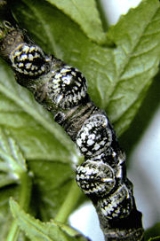
Eulecanium cerasorum
Encyclopedia
Eulecanium cerasorum, the calico scale, is species of scale insect
. It can be identified by its white and brown color on its outer circular shell which will continuously darken over age. It is approximately one quarter of an inch in diameter. The Calico Scale is a pest to many trees in the United States, including dogwood
s, honey locust
, magnolia
s, maple
s, sweetgums
and fruit trees. This pest typically attacks the branches which stresses the trees. Mature females produce honeydew
, which promotes the growth of mold
around the tree.
The nymph migrates along a tree branch, then settles down and creates a circular hardened shell or cap to be its protective coat against predators and pesticides. The typical female is known to lay around 4500 eggs inside its cap.
Scale insect
The scale insects are small insects of the order Hemiptera, generally classified as the superfamily Coccoidea. There are about 8,000 species of scale insects.-Ecology:...
. It can be identified by its white and brown color on its outer circular shell which will continuously darken over age. It is approximately one quarter of an inch in diameter. The Calico Scale is a pest to many trees in the United States, including dogwood
Dogwood
The genus Cornus is a group of about 30-60 species of woody plants in the family Cornaceae, commonly known as dogwoods. Most dogwoods are deciduous trees or shrubs, but a few species are nearly herbaceous perennial subshrubs, and a few of the woody species are evergreen...
s, honey locust
Honey locust
The Honey locust, Gleditsia triacanthos, is a deciduous tree native to central North America. It is mostly found in the moist soil of river valleys ranging from southeastern South Dakota to New Orleans and central Texas, and as far east as eastern Massachusetts.-Description:Honey locusts, Gleditsia...
, magnolia
Magnolia
Magnolia is a large genus of about 210 flowering plant species in the subfamily Magnolioideae of the family Magnoliaceae. It is named after French botanist Pierre Magnol....
s, maple
Maple
Acer is a genus of trees or shrubs commonly known as maple.Maples are variously classified in a family of their own, the Aceraceae, or together with the Hippocastanaceae included in the family Sapindaceae. Modern classifications, including the Angiosperm Phylogeny Group system, favour inclusion in...
s, sweetgums
Liriodendron
Liriodendron is a genus of two species of characteristically large deciduous trees in the magnolia family .These trees are widely known by the common name tulip tree or tuliptree for their large flowers superficially resembling tulips, but are closely related to magnolias rather than lilies, the...
and fruit trees. This pest typically attacks the branches which stresses the trees. Mature females produce honeydew
Honeydew (secretion)
Honeydew is a sugar-rich sticky liquid, secreted by aphids and some scale insects as they feed on plant sap. When their mouthpart penetrates the phloem, the sugary, high-pressure liquid is forced out of the gut's terminal opening. Honeydew is particularly common as a secretion in the Hemipteran...
, which promotes the growth of mold
Mold
Molds are fungi that grow in the form of multicellular filaments called hyphae. Molds are not considered to be microbes but microscopic fungi that grow as single cells called yeasts...
around the tree.
The nymph migrates along a tree branch, then settles down and creates a circular hardened shell or cap to be its protective coat against predators and pesticides. The typical female is known to lay around 4500 eggs inside its cap.

